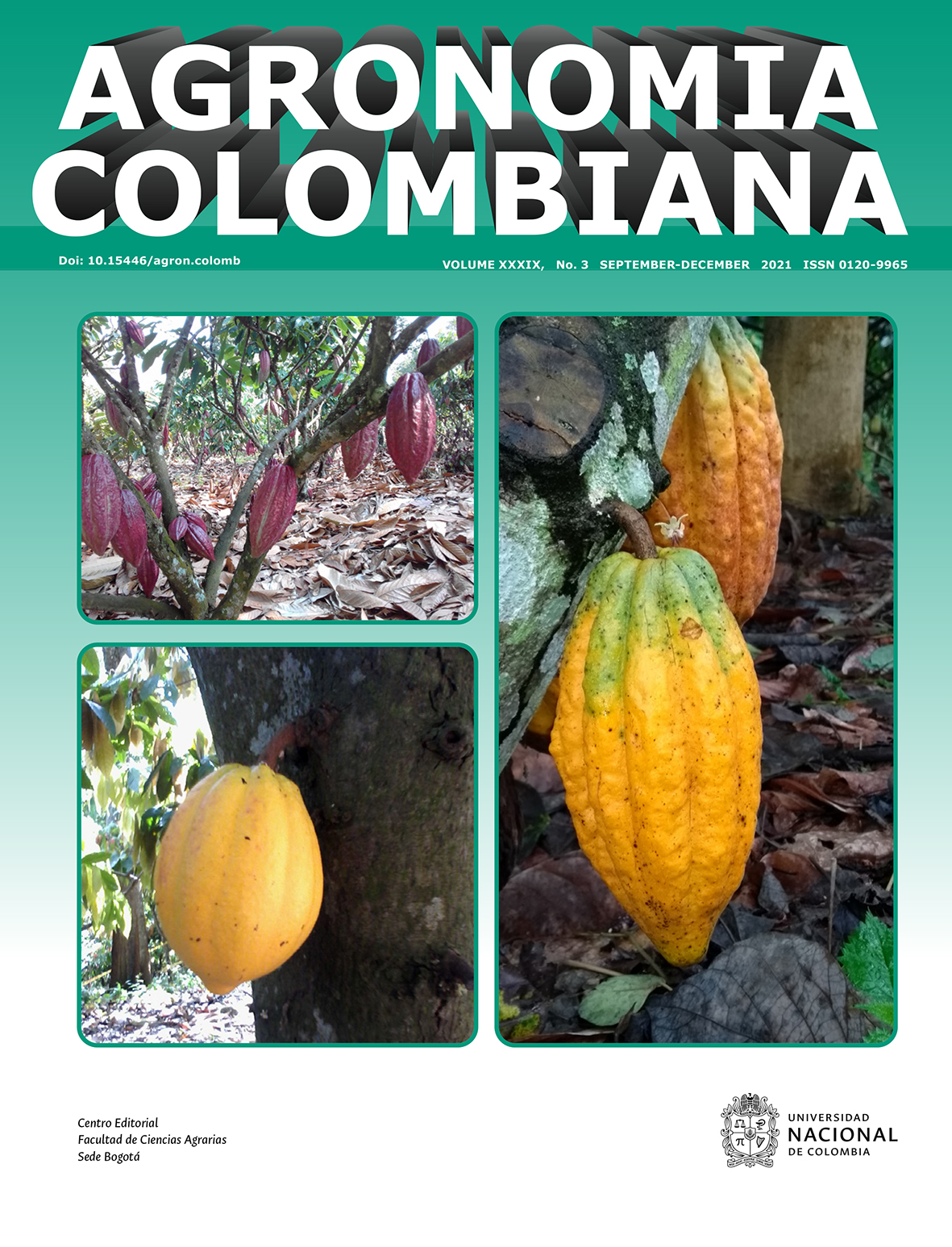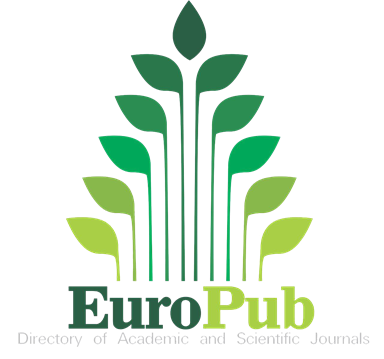Improvement of growth of common bean in phosphorus-deficient soils by phosphate-solubilizing and phytohormone-producing bacteria
Mejoramiento del crecimiento del frijol común en suelos deficientes en fósforo por bacterias solubilizadoras de fosfato y productoras de fitohormonas
DOI:
https://doi.org/10.15446/agron.colomb.v39n3.95461Keywords:
phosphate fertilizer, plant growth-promoting bacteria, legume (en)fertilizante de fosfato, bacterias promotoras del crecimiento de plantas, leguminosas (es)
Downloads
The use of phosphate fertilizers is generally required for normal growth and development of crops. The cost of manufactured phosphate fertilizers has increased drastically in recent years and these are becoming out of reach for low-income farmers. The objective of this research was to select phosphate-solubilizing and phytohormone-producing bacteria to improve the growth and P uptake by the common bean (IAC Alvorada) in Red-Yellow Oxisol without the addition of phosphate fertilizer. The experimental design was completely randomized with three replicates and the following treatments: non-inoculated bean plants and plants inoculated separately with seven bacterial isolates: K24, K36, K71, T30, T79, A24, and T22. The previously treated bean plants were grown in the presence and absence of phosphate fertilization. Only the plants inoculated with the isolates K36 and T79 showed higher values for the dry weight and the quantities of P and N uptake by the shoot when cultivated in the absence of phosphate fertilizer. These results demonstrate the potential use of the bacteria T79 and K36 as inoculants for bean plants grown in non-sterilized soil with low available P content, but also indicate that P solubilization may not be the only mechanism responsible for the positive growth response.
El uso de fertilizantes fosfatados se requiere generalmente para el crecimiento y desarrollo normal de los cultivos. El costo de estos fertilizantes ha incrementado drásticamente en los últimos años, y están fuera del alcance de los agricultores de bajos ingresos. El objetivo de esta investigación fue seleccionar bacterias solubilizadoras de fosfato y productoras de fitohormonas para mejorar el crecimiento y la absorción de P del frijol común (IAC alvorada) en un Oxisol Rojo-Amarillo sin la adición de fertilizante fosfatado. El diseño experimental fue completamente al azar con tres repeticiones y los siguientes tratamientos: plantas de frijoles no inoculadas y plantas de frijoles inoculadas por separado con siete aislamientos bacterianos: K24, K36, K71, T30, T79, A24 y T22. Las plantas de frijoles previamente tratadas se cultivaron en presencia y ausencia de fertilización con fosfato. Solo las plantas inoculadas con los
aislamientos K36 y T79 presentaron valores más altos para el peso seco y para las cantidades de captación de P y N por la parte aérea cuando se cultivaron en ausencia de fertilizante fosfatado. Estos resultados demuestran el uso potencial de los aislamientos bacterianos T79 y K36 como inoculantes para frijol cultivado en suelos no esterilizados con un bajo contenido de P disponible, pero también indican que la solubilización de P posiblemente no fue el único mecanismo responsable de la respuesta positiva del crecimiento.
References
Assalin, M. R., Piovesana, A. M., Rosa, M. A., Ferracini, V. L., & Vieira, R. F. (2011, December, 10–13). Identificação e quantificação de fitohormônios produzidos por bactérias por UPLCESI-MSMS [Conference presentation]. Congresso Brasileiro de Espectrometria de Massas, Campinas, Brazil.
Atlas, R. M. (2004). Handbook of microbiological media (3rd ed.). CRC Press.
Baig, K. S., Arshad, M., Shaharoona, B., Khalid, A., & Ahmed, I. (2012). Comparative effectiveness of Bacillus spp. possessing either dual or single growth-promoting traits for improving phosphorus uptake, growth and yield of wheat (Triticum aestivum L.). Annals of Microbiology, 62, 1109–1119. https://doi.org/10.1007/s13213-011-0352-0
Barra, P. J., Pontigo, S., Delgado, M., Parra-Almuna, L., Duran, P., Valentine, A. J., Jorquera, M. A., & Mora, M. L. (2019). Phosphobacteria inoculation enhances the benefit of P-fertilization on Lolium perenne in soils contrasting in P-availability. Soil Biology and Biochemistry, 136, Article 107516. https://doi.org/10.1016/j.soilbio.2019.06.012
Bashan, Y., Kamnev, A. A., & Bashan, L. E. (2013). A proposal for isolating and testing phosphate-solubilizing bacteria that enhance plant growth. Biology and Fertility of Soils, 49, 1–2. https://doi.org/10.1007/s00374-012-0756-4
Bowman, R. A. (1989). A rapid plant digestion method for analysis of P and certain cations by inductively coupled plasma emission spectrometry. Communications in Soil Science and Plant Analysis, 20(5–6), 539–553. https://doi.org/10.1080/00103628909368099
Camargo, O. A., Moniz, A. C., Jorge, J. A., & Valadares, J. M. A. S. (2009). Métodos de análise química, mineralógica e física de solos do Instituto Agronômico de Campinas. Boletim Técnico 106. Instituto Agronômico de Campinas.
Cassán, F., Vanderleyden, J., & Spaepen, S. (2014). Physiological and agronomical aspects of phytohormone production by model plant-growth-promoting rhizobacteria (PGPR) belonging to the genus Azospirillum. Journal of Plant Growth Regulation, 33, 440–459. https://doi.org/10.1007/s00344-013-9362-4
Collavino, M. M., Sansberro, P. A., Mroginski, L. A., & Aguilar, O. M. (2010). Comparison of in vitro solubilization activity of diverse phosphate-solubilizing bacteria native to acid soil and their ability to promote Phaseolus vulgaris growth. Biology and Fertility of Soils, 46, 727–738. https://doi.org/10.1007/s00374-010-0480-x
Cordell, D., Drangert, J. O., & White, S. (2009). The story of phosphorus: global food security and food for thought. Global Environmental Change, 19(2), 292–305. https://doi.org/10.1016/j.gloenvcha.2008.10.009
De Bolle, S., Gebremikael, M. T., Maervoet, V., & De Neve, S. (2013). Performance of phosphate-solubilizing bacteria in soil under high phosphorus conditions. Biology and Fertility of Soils, 49, 705–714. https://doi.org/10.1007/s00374-012-0759-1
De Freitas, J. R., Banerjee, M. R., & Germida, J. J. (1997). Phosphate-solubilizing rhizobacteria enhance the growth and yield but not phosphorous uptake of canola (Brassica napus L.). Biology and Fertility of Soils, 24, 358–364. https://doi.org/10.1007/s003740050258
Elkoca, E., Turan, M., & Donmez, M. F. (2010). Effects of single, dual and triple inoculations with Bacillus subtilis, Bacillus megaterium and Rhizobium leguminosarum bv. phaseoli on nodulation, nutrient uptake, yield and yield parameters of common bean (Phaseolus vulgaris L. cv. ‘Elkoca-05’). Journal of Plant Nutrition, 33(14), 2104–2119. https://doi.org/10.1080/01904167.2010.519084
Gentili, F., Wall, L. G., & Huss-Danell, K. (2006). Effects of phosphorus and nitrogen on nodulation are seen already at the stage of early cortical cell divisions in Alnus incana. Annals of Botany, 98(2), 309–315. https://doi.org/10.1093/aob/mcl109
Khan, M. S., Zaidi, A., Ahemad, M., Oves, M., & Wani, P. A. (2010). Plant growth promotion by phosphate solubilizing fungi - current perspective. Archives of Agronomy and Soil Science, 56(1), 73–98. https://doi.org/10.1080/03650340902806469
Kouas, S., Labidi, N., Debez, A., & Abdelly, C. (2005). Effect of P on nodule formation and N fixation in bean. Agronomy for Sustainable Development, 25(3), 389–393. https://doi.org/10.1051/agro:2005034
Lavakush, Janardan, Y., Verma, J. P., Jaiswal, D. K., & Kumar, A. (2014). Evaluation of PGPR and different concentration of phosphorus level on plant growth, yield and nutrient content of rice (Oryza sativa). Ecological Engineering, 62, 123–128. https://doi.org/10.1016/j.ecoleng.2013.10.013
Lee, S., Ka, J. O., & Song, H. G. (2012). Growth promotion of Xanthium italicum by application of rhizobacterial isolates of Bacillus aryabhattai in microcosm soil. The Journal of Microbiology, 50(1), 45–49. https://doi.org/10.1007/s12275-012-1415-z
Li, Y., Liu, X., Hao, T., & Chen, S. (2017). Colonization and maize growth promotion induced by phosphate solubilizing bacterial isolates. International Journal of Molecular Sciences, 18(7), Article 1253. https://doi.org/10.3390/ijms18071253
Liu, F., Xing, S., Ma, H., Du, Z., & Ma, B. (2013). Cytokinin-producing, plant growth-promoting rhizobacteria that confer resistance to drought stress in Platycladus orientalis container seedlings. Applied and Microbiology and Biotechnology, 97, 9155–9164. https://doi.org/10.1007/s00253-013-5193-2
Malboobi, M. A., Zamani, K., Lohrasebi, T., Sarikhani, M. R., Samaian, A., & Sabet, M. S. (2014). Phosphate: the silent challenge. Progress in Biological Sciences, 4(1), 1–32. https://doi.org/10.22059/pbs.2014.50302
Masniawaty, Mustari, K., Astuti, Gusmiaty, Larekeng, H., Yani, A., & Rahim, I. (2019). Exploration of bacteria associated with chili peppers’ rhizosphere and their capacity to absorb and produce gibberellin hormone. IOP Conference Series: Earth and Environmental Science, 343, Article 012059. https://doi.org/10.1088/1755-1315/343/1/012059
Murphy, J., & Riley, J. P. (1962). A modified single solution method for the determination of phosphate in natural waters. Analytica Chimica Acta, 27, 31–36. https://doi.org/10.1016/S0003-2670(00)88444-5
Nautiyal, C. S. (1999). An efficient microbiological growth medium for screening phosphate solubilizing microorganisms. FEMS Microbiology Letters, 170(1), 265–270. https://doi.org/10.1111/j.1574-6968.1999.tb13383.x
Oliveira, M. G. C., Oliveira, L. F. C., Wendland, A., Guimarães, C. M., Quintela, E. D., Barbosa, F. R., Carvalho, M. C. S., Lobo Junior, M., & Silveira, P. M. (2018). Conhecendo a fenologia do feijoeiro e seus aspectos fitotécnicos. Embrapa.
Oliveira-Longatti, S. M., Souza, P. M., Marra, L. M., Ferreira, P. A. A., & Moreira, F. M. S. (2015). Burkholderia fungorum promotes common bean growth in a dystrophic oxisol. Annals of Microbiology, 65, 1825–1832. https://doi.org/10.1007/s13213-014-1020-y
Olszewski, N., Sun, T. P., & Gubler, F. (2002). Gibberellin signaling: biosynthesis, catabolism, and response pathways. The Plant Cell, 14(suppl_1), S61–S80. https://doi.org/10.1105/tpc.010476
Peix, A., Mateos, P. F., Rodriguez-Barrueco, C., Martinez-Molina, E., & Velazquez, E. (2001). Growth promotion of common bean (Phaseolus vulgaris L.) by a strain of Burkholderia cepacia under growth chamber conditions. Soil Biology and Biochemistry, 33(14), 1927–1935. https://doi.org/10.1016/S0038-0717(01)00119-5
Pereira, S. I. A., & Castro, P. M. L. (2014). Phosphate-solubilizing rhizobacteria enhance Zea mays growth in agricultural P-deficient soils. Ecological Engineering, 73, 526–535. https://doi.org/10.1016/j.ecoleng.2014.09.060
R Core Team. (2020). R: a language and environment for statistical computing. R Foundation for Statistical Computing. https://www.R-project.org/
Sadiq, H. M., Jahangir, G. Z., Nasir, I. A., Iqtidar, M., & Iqbal, M. (2013). Isolation and characterization of phosphate-solubilizing bacteria from rhizosphere soil. Biotechnology & Biotechnological Equipment, 27(6), 4248–4255. https://doi.org/10.5504/BBEQ.2013.0091
Sharma, S. B., Sayyed, R. Z., Trivedi, M. H., & Gobi, T. A. (2013). Phosphate solubilizing microbes: sustainable approach for managing phosphorus deficiency in agricultural soils. SpringerPlus, 2, Article 587. https://doi.org/10.1186/2193-1801-2-587
Souza, T. L. P. O., Faleiro, F. G., Dessaune, S. N., Paula-Junior, T. J., Moreira, M. A., & Barros, E. G. (2013). Breeding for common bean (Phaseolus vulgaris L.) rust resistance in Brazil. Tropical Plant Pathology, 38(5), 361–374. https://doi.org/10.1590/S1982-56762013005000027
Tahir, M., Mirza, M. S., Zaheer, A., Dimitrov, M. R., Smidt, H., & Hameed, S. (2013). Isolation and identification of phosphate solubilizer Azospirillum, Bacillus and Enterobacter strains by 16SrRNA sequence analysis and their effect on growth of wheat (Triticum aestivum L.). Australian Journal of Crop Science, 7(9), 1284–1292.
Talboys, P. J., Owen, D. W., Healey, J. R., Withers, P. J. A., & Jones, D. L. (2014). Auxin secretion by Bacillus amyloliquefaciens FZB42 both stimulates root exudation and limits phosphorus uptake in Triticum aestivum. BMC Plant Biology, 14, Article 51. https://doi.org/10.1186/1471-2229-14-51
Tedesco, M. J., Gianello, C., Bissani, C. A., Bohnen, H., & Volkweiss, S. J. (1995). Análises de solo, plantas e outros materiais. UFRGS.
Widdig, M., Schleuss, P. M., Weig, A. R., Guhr, A., Biederman, L. A., Borer, E. T., Crawley, M. J., Kirkman, K. P., Seabloom, E. W., Wragg, P. D., & Spohn, M. (2019). Nitrogen and phosphorus additions alter the abundance of phosphorus-solubilizing bacteria and phosphatase activity in grassland soils. Frontiers in Environmental Science, 7, Article 185. https://doi.org/10.3389/fenvs.2019.00185
Yang, B., Wang, X. M., Ma, H. Y., Jia, Y., Li, X., & Dai, C. C. (2014). Effects of the fungal endophyte Phomopsis liquidambari on nitrogen uptake and metabolism in rice. Plant Growth Regulation, 73, 165–179. https://doi.org/10.1007/s10725-013-9878-4
Zhang, X., Davidson, E. A., Mauzerall, D. L., Searchinger, T. D., Dumas, P., & Shen, Y. (2015). Managing nitrogen for sustainable development. Nature, 528, 51–59. https://doi.org/10.1038/nature15743
How to Cite
APA
ACM
ACS
ABNT
Chicago
Harvard
IEEE
MLA
Turabian
Vancouver
Download Citation
CrossRef Cited-by
1. Juan Pablo Hernández, Edgar Palacios-Ortega, Helber Enrique Balaguera-López. (2025). Plant growth promoting bacteria as a tool to mitigate salt stress in crops: A review. Agronomía Colombiana, 43(1), p.e117690. https://doi.org/10.15446/agron.colomb.v43n1.117690.
2. Everlon Cid Rigobelo. (2024). Microbial Services for Cereal Crops. , p.1. https://doi.org/10.1007/978-3-031-63149-8_1.
3. Laiana Lana Bentes Lobo, Maura Santos Reis de Andrade da Silva, Tereza Cristina Luque Castellane, Rogério Falleiros Carvalho, Everlon Cid Rigobelo. (2022). Effect of Indole-3-Acetic Acid on Tomato Plant Growth. Microorganisms, 10(11), p.2212. https://doi.org/10.3390/microorganisms10112212.
Dimensions
PlumX
Article abstract page views
Downloads
License
Copyright (c) 2021 Agronomía Colombiana

This work is licensed under a Creative Commons Attribution-NonCommercial-ShareAlike 4.0 International License.
© Centro Editorial de la Facultad de Ciencias Agrarias, Universidad Nacional de Colombia
Reproduction and quotation of material appearing in the journal is authorized provided the following are explicitly indicated: journal name, author(s) name, year, volume, issue and pages of the source. The ideas and observations recorded by the authors are their own and do not necessarily represent the views and policies of the Universidad Nacional de Colombia. Mention of products or commercial firms in the journal does not constitute a recommendation or endorsement on the part of the Universidad Nacional de Colombia; furthermore, the use of such products should comply with the product label recommendations.
The Creative Commons license used by Agronomia Colombiana journal is: Attribution - NonCommercial - ShareAlike (by-nc-sa)

Agronomia Colombiana by Centro Editorial of Facultad de Ciencias Agrarias, Universidad Nacional de Colombia is licensed under a Creative Commons Reconocimiento-NoComercial-CompartirIgual 4.0 Internacional License.
Creado a partir de la obra en http://revistas.unal.edu.co/index.php/agrocol/.




















